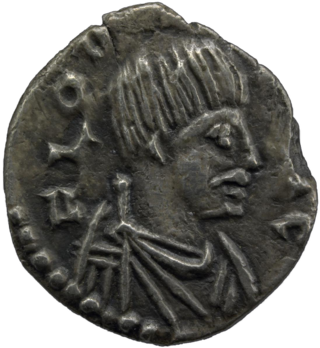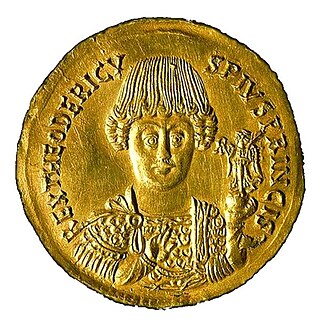Related Research Articles

The Ostrogoths were a Roman-era Germanic people. In the 5th century, they followed the Visigoths in creating one of the two great Gothic kingdoms within the Roman Empire, based upon the large Gothic populations who had settled in the Balkans in the 4th century, having crossed the Lower Danube. While the Visigoths had formed under the leadership of Alaric I, the new Ostrogothic political entity which came to rule Italy was formed in the Balkans under the influence of the Amal dynasty, the family of Theodoric the Great.

Theodoricthe Great, also called Theodoric the Amal, was king of the Ostrogoths (475–526), and ruler of the independent Ostrogothic Kingdom of Italy between 493 and 526, regent of the Visigoths (511–526), and a patrician of the Eastern Roman Empire. As ruler of the combined Gothic realms, Theodoric controlled an empire stretching from the Atlantic Ocean to the Adriatic Sea. Though Theodoric himself only used the title 'king' (rex), some scholars characterize him as a Western Roman Emperor in all but name, since he ruled large parts of the former Western Roman Empire, had received the former Western imperial regalia from Constantinople in 497, and was referred to by the title augustus by some of his subjects.

Odoacer, also spelled Odovacer or Odovacar, was a barbarian soldier and statesman from the Middle Danube who deposed the Western Roman child emperor Romulus Augustulus and became the ruler of Italy (476–493). Odoacer's overthrow of Romulus Augustulus is traditionally seen as marking the end of the Western Roman Empire.
The Amali – also called Amals, Amalings or Amalungs – were a leading dynasty of the Goths, a Germanic people who confronted the Roman Empire during the decline of the Western Roman Empire. They eventually became the royal house of the Ostrogoths and founded the Ostrogothic Kingdom.

The Ostrogothic Kingdom, officially the Kingdom of Italy, existed under the control of the Germanic Ostrogoths in Italy and neighbouring areas from 493 to 553.
Widin was the last attested Ostrogothic noble in Italy. After Teia's defeat at the hands of the Byzantine eunuch general Narses at the Battle of Mons Lactarius, south of present-day Naples, in October 552 or early 553, organized Ostrogothic resistance ended. Widin, however, was able to organize a Gothic revolt in northern Italy in 561. According to Paul the Deacon, Widin comes Gothorum and Amingus, a Frank, rebelled against Narses.
Patrick Amory is a historian and an executive in the recorded music industry.
Eutharic Cilliga was an Ostrogothic prince from Iberia who, during the early 6th century, served as Roman Consul and "son in weapons" alongside the Byzantine emperor Justin I. He was the son-in-law and presumptive heir of the Ostrogoth king Theodoric the Great but died in AD 522 at the age of 42 before he could inherit Theodoric's title. Theodoric claimed that Eutharic was a descendant of the Gothic royal house of Amali and it was intended that his marriage to Theodoric's daughter Amalasuintha would unite the Gothic kingdoms, establish Theodoric's dynasty and further strengthen the Gothic hold over Italy.
Gennadius Avienus was an influential politician of the Western Roman Empire. He was consul in 450, alongside Valentinian III. In 452, he was an envoy to Attila; together with Pope Leo I and Trigetius he successfully negotiated a truce. He had a son and a daughter; his son would go on to be consul in 490.
Rodelinda (6th-century), was a Lombard queen by marriage to king Audoin, and mother of king Alboin.
Anonymus Valesianus is the conventional title of a compilation of two fragmentary vulgar Latin chronicles, named for its modern editor, Henricus Valesius, who published the texts for the first time in 1636, together with his first printed edition of the Res Gestae of Ammianus Marcellinus. The two fragments are not related, one being from the fourth century and the other from the sixth. The only connection between the two fragments is their presence in the same manuscript and their history of being edited together. When Henricus' brother Hadrian re-edited the Anonymus in an edition of Ammianus Marcellinus in 1681, it was the first time that the two excerpts were clearly separated.
Baduarius was a Byzantine general, active early in the reign of Justinian I in Scythia Minor.
Mataswintha, also spelled Matasuintha, Matasuentha, Mathesuentha, Matasvintha, or Matasuntha, was a daughter of Eutharic and Amalasuintha. She was a sister of Athalaric, King of the Ostrogoths. Their maternal grandparents were Theodoric the Great and Audofleda.
Elemund was king of the Gepids, an east Germanic people, during the first half of the 6th century. He may have been the son of Gunderit, himself son of Ardaric ascended by overthrowing a rival Ardariking branch. Based on archaeological evidence, István Boná believes that in the 520s or 530s Elemund must have consolidated his power in Transylvania by submitting or removing minor Gepid rulers. Elemund had a son and daughter, Ostrogotha and Austrigusa, respectively; the latter was given in marriage to Wacho, the king of the Lombards, in 512. The reasons behind the marriage were multiple: on one side it protected the two kings from the threat represented by the Ostrogothic Kingdom, while on the other it reduced the danger represented to the Lombard king by Ildechis, a pretender to the Lombard throne. Wacho was eventually to remarry after Austrigusa's death, but this did not compromise the good relations existing between Lombards and Gepids. Elemund died of illness in 548 and was succeeded by Thurisind, while the legitimate heir was forced into exile. Ostrogotha found hospitality among the Lombards, but was killed in 552 by his host, King Audoin, as part of a plan to ease relations between Gepids and Lombards.
Ostrogothic Ravenna refers to the time period in which Ravenna, a city in Northeastern Italy, served as the capital of the Ostrogothic Kingdom, which existed between 493 and 553 CE. During that time, Ravenna saw a great renovation, in particular under Theodoric the Great (454–526). During his rule, Ravenna saw many of its finest monuments constructed or renovated, including the Basilica of Sant'Apollinare Nuovo, the Palace of Theoderic, and Mausoleum of Theodoric. Many of these monuments reflect the Arian faith of Theodoric and the Goths. Though an Arian Christian himself, Theodoric's rule was a time of religious tolerance in the city of Ravenna. His religious tolerance extended also to forging a balance between the Romans and Goths in Ravenna. Theodoric attempted to model Ravenna as a capital equivalent to that of Rome or Constantinople and as such was a defender of classical antiquity in a western world that saw much of its classical heritage disappearing.
Ascum was a general of the Byzantine Empire, active early in the reign of Justinian I. He was in command of the Praetorian prefecture of Illyricum. His name is reported by John Malalas. Both Theophanes the Confessor and George Kedrenos render his name "Ακούμ" (Acum).
Ragnaris was a Hunnic warlord who fought for the Ostrogoths in the final stages of the Gothic War against the Eastern Roman Empire. Procopius calls him a Goth, but the better informed Agathias records that he was of the Hunnic tribe of the Vittores or Vitgores.
Asbadus was a Gepid leader fighting for the Eastern Roman Empire against the Ostrogoths in the final stages of the Gothic War.
Vacis was an Ostrogothic commander under King Witigis during the Byzantine–Gothic War (535–554).
Ostrogotho was the daughter of the Ostrogothic king Theodoric the Great, and the wife of the Burgundian king Sigismund.
References
- 1 2 3 4 Amory, Patrick (1997). People and Identity in Ostrogothic Italy, 489-554. Cambridge: Cambridge University Press. p. 450. ISBN 0-521-57151-0.
- ↑ Amory, Patrick (1997). People and Identity in Ostrogothic Italy, 489-554. Cambridge: Cambridge University Press. pp. 268–269. ISBN 0-521-57151-0.
- ↑ See Anonymus Valesianus Pars Posterior: Chronica Theodericiana . The Latin Library.